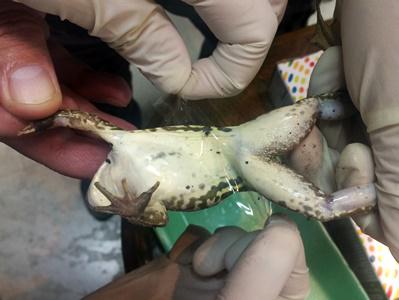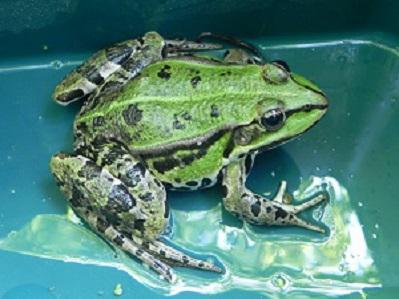Katarina Breka
The goal of this study is to examine the effect of epizootic communities found on frogs’ skin on their health and survivorship with the special attention paid to the presence of the the zoosporic fungus Batrachochytrium dendrobatidis. We will also establish the threatening factors and develop an effective protection and monitoring program.

Sampling with adhesive tape strips.
As part of a global biodiversity loss, amphibian populations are declining throughout the world. Numerous factors, including pathogens, introduced species, contaminants, habitat destruction and global environmental changes are contributing to amphibian populations’ decline.

Pelophylax sp.
Serbia is populated by three taxa from the Western Palearctic group of green frogs: Marsh frog (Pelophylax ridibundus), pool frog (Pelophylax lessonae) and their hybrid edible frog (Pelophylax kl. esculentus). Green frogs in Serbia faces very severe threats including inappropriate alteration of their native habitats (fragmentation, deterioration, destruction), increased and uncontrolled pressure from infrastructure projects, pollution, illegal collecting for commercial purposes and global climatic change. The fungal disease, chytridiomycosis as a new threat has not been officially detected in the area but there is a certain risk of emerging.
There is no relevant data on population parameters, habitat characteristics or impact of certain threatening factors on these frogs in Serbia. Collected data will be of great importance for future monitoring programs and conservation efforts of the frogs and their habitats.
We plan to achieve following objectives:
- Evaluate epizootic communities that colonize the amphibian skin (especially the possible presence of invasive chytrid fungus Batrachochytrium dendrobatidis, the causative agent of the amphibian skin disease chytridiomycosis.)
- Investigate the possible relation between epizootic community and frog’s fitness and/or other measure of individual performance.
- Evaluate if there is a difference in epizootic communities among different species of Pelophylax synclepton esculenta complex.
- Evaluate whether the disturbance of epizootic communities facilitates skin colonization of fungus Batrachochytrium dendrobatidis.
- Determine the movement patterns and habitat corridors between localities in the southeastern part of the Panonian plain, in Banat.
- Describe in detail characteristics of their habitat. Examine and determine patterns and preferences in micro- and macro- habitat utilisation.
- Publish research results in international journals and symposiums.
- Give lectures and poster presentations in local schools about the importance of frogs in ecosystems, with a special focus on green frogs.
- Establish connections with regional NGOs to build up future partnership in developing conservation strategies for the green frogs, particularly related to frog exploitation.
- Raising the awareness of local and regional officials involved in quota and permit regulations for green frog exploitation on current threats and prospects.
- Educating and raising awareness of the local community on green frogs and the need of protection of the species and their habitats.